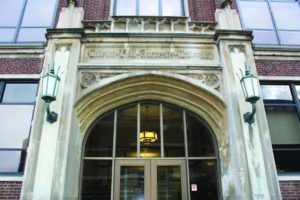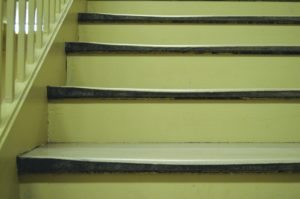

The arched entrance to Canevin Hall. Construction of Canevin began in 1922.
Jamie Crow | Staff Writer
Worn into Canevin Hall’s marble stairs are grooves from years of student use — a sign of the history that makes them more than just a way to get from one floor to another.
For Cindy Cafaro, office assistant for student and academic services in Canevin Hall, the stairs are a reminder of her late husband, who was a student in the school of education. Every day that she walks up the stairs to her office, she takes note of the grooves and is reminded of her husband’s journey as a student and of his time spent at Duquesne.
“He walked up these stairs,” Cafaro said of her husband, with a smile.
Cafaro added that seeing such a visual representation of the history of the building, and of the students who have occupied it, is something really special. Her story shows that there is clearly more to Canevin Hall than just its old architecture and its classic aesthetic. Delving into the history books is well worth it to discover the legacy that the building holds.
Canevin Hall was named for Archbishop J. F. Regis Canevin, a man whose life was dedicated to serving the Pittsburgh community through his faith. According to the Catholic Hierarchy, Canevin was born in 1853 in Latrobe, and attended Saint Vincent College. Initially enrolled as a theology student, he continued his education at the Saint Vincent Seminary, where he was ordained as a priest on June 4, 1879.
Archbishop Canevin served the Pittsburgh community as a priest for 24 years until he became an ordained Bishop on Feb. 24, 1903. His time as a Bishop continued for over 25 years, and in 1921, he was named the Titular Archbishop of Pelusium, six years before his death in 1927 at the age of 73.

The original marble-capped staircases are worn down with grooves from many decades of student use.
The history of the building itself began with the laying of the corner stone. That may sound like a routine procedure, but according to the Pittsburgh Post-Gazette, on Oct. 29, 1922, hundreds of people attended to watch the foundational ceremony. Archbishop J. F. Regis Canevin blessed and laid the stone in the building that would be dedicated to him and bear his name.
Canevin Hall hasn’t always been the home of the school of education. According to Thomas White, the university archivist, the pharmacy school used to run a pharmacy on the first floor of Canevin Hall. For most of the building’s history, however, it has been used for classroom space, much like it is today.
One might expect that a building as old as Canevin Hall would have some quirks to it, but Cafaro said that the latest updates to the building were made eight years ago, and that all of the renovations have eliminated any expected problems with its age.
The interior of Canevin Hall has changed drastically over its nearly 100 year history. Cafaro said that there used to be lights similar to chandeliers that hung from drop ceilings. She also said that there was a cafeteria in the basement of the building, a far stretch from the few classrooms that occupy the basement today.
We walk past buildings like Canevin Hall everyday without stopping to think about their history. It’s important to realize that the buildings on Duquesne’s campus have a story, and the paths we take have been taken before. The grooves in the stairs of Canevin Hall prove that, and they continue to hold the legacy of Cafaro’s husband and all of the students who came before us.



